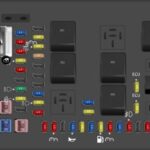Experiencing trouble connecting your OBD2 scanner to your 2002 Ford F250? You’re not alone. Many owners of the robust 7.3L PowerStroke diesel engine encounter situations where their OBD-II port seems unresponsive. Before assuming a major electronic malfunction, a simple first step in diagnosing this issue is to check the 2002 F250 Obd2 Fuse. This article will guide you through troubleshooting steps, focusing on the fuse and other potential culprits behind a non-communicative OBD2 port in your 2002 F250.
Common OBD2 Port Problems in the 2002 F250
For owners of the 2002 Ford F250, a non-functional OBD2 port can be a frustrating hurdle, especially when trying to diagnose engine lights or monitor vehicle performance. The On-Board Diagnostics II (OBD2) system is crucial for modern vehicle maintenance and repair. When your OBD2 scanner fails to connect, it prevents you from reading diagnostic trouble codes (DTCs) or accessing real-time data from your truck’s computer. While a faulty PCM (Powertrain Control Module) or wiring issues can be the root cause, often the problem can be as simple as a blown fuse.
Checking the OBD2 Fuse in Your 2002 F250
The fuse box is the first place to investigate when your OBD2 port is not working. For a 2002 Ford F250, the fuse relevant to the OBD2 port is often shared with other circuits, such as the cigarette lighter or accessory power. Locating the exact fuse is crucial:
- Consult Your Owner’s Manual: Your 2002 F250 owner’s manual is the definitive guide to fuse box locations and fuse designations. Look for a fuse diagram, typically found in the owner’s manual, which will pinpoint the fuse for the “diagnostic port,” “OBD-II,” “cigarette lighter,” or “accessory power.”
- Fuse Box Location: Typically, the main fuse box in a 2002 F250 is located under the dashboard on the driver’s side or under the hood. Refer to your manual for the exact location.
- Identify the Correct Fuse: Once you’ve located the fuse box, use the diagram to find the fuse associated with the OBD2 port. It might be labeled as “Cigar Lighter,” “Accessory Outlet,” or specifically “OBDII.” In some cases, it could be a fuse related to the PCM power supply.
- Inspect the Fuse: Visually inspect the fuse. A blown fuse will often have a broken filament inside. For a more definitive check, use a multimeter to test for continuity across the fuse terminals.
- Replace if Necessary: If the fuse is blown, replace it with a new fuse of the same amperage rating. Using a fuse with a higher amperage rating can cause damage to the electrical system.
Beyond the Fuse: Other Potential Causes of OBD2 Port Failure
If replacing the 2002 f250 OBD2 fuse doesn’t solve the communication issue, other potential problems need to be considered:
- OBD2 Port Corrosion or Damage: The OBD2 port itself can suffer from corrosion, especially in vehicles exposed to harsh environments. Inspect the pins inside the OBD2 port for any signs of rust or damage. Using a contact cleaner like DeOxit D5, as mentioned in the original post, can help improve connectivity if corrosion is present.
- Wiring Issues: Damaged or broken wires leading to the OBD2 port can interrupt the communication signal. Check the wiring harness around the OBD2 port for any visible damage, cuts, or fraying. A wiring diagram for your 2002 F250 can be helpful in tracing the wires back to the PCM.
- PCM Malfunction: While less common, a malfunctioning PCM can also cause OBD2 port issues. If the PCM is not properly powering or communicating with the OBD2 port, scanners will fail to connect. However, PCM failures often present with other symptoms and trouble codes.
Diagnostic Steps Already Taken (Based on Original Post)
The original poster has already taken several logical steps to troubleshoot their 2002 F250 OBD2 port issue, which are good examples of a systematic approach:
- Multiple Scanner Tests: Trying different OBD2 scanners, including a higher-end Actron scanner and an Edge Evolution programmer, helps rule out a problem with a specific scanner.
- Fuse Inspection and Swapping: Checking and even swapping fuses is a standard and effective first step in electrical troubleshooting.
- Contact Cleaner Application: Using DeOxit D5 on the OBD2 port addresses potential corrosion issues.
- Battery Disconnection: Disconnecting the batteries is a common method to reset the PCM, which can sometimes resolve temporary communication glitches.
Next Steps for Troubleshooting Your 2002 F250 OBD2 Port
If you’ve checked the 2002 f250 OBD2 fuse and performed the basic troubleshooting steps without success, more in-depth diagnostics might be necessary:
- Detailed Wiring Inspection: Carefully inspect the wiring from the OBD2 port back to the PCM, looking for breaks, shorts, or damage. Use a multimeter to check for voltage and continuity on the OBD2 port pins, referencing a wiring diagram for pin assignments.
- PCM Diagnostic Testing: Diagnosing a PCM issue often requires specialized tools and expertise. If you suspect a PCM malfunction, consider seeking professional help from a qualified mechanic or a shop specializing in Ford PowerStroke diesels.
- Consult a Professional: If you’re not comfortable with electrical troubleshooting or PCM diagnostics, taking your 2002 F250 to a trusted mechanic is the most prudent step. They have the tools and expertise to accurately diagnose and repair complex OBD2 port issues.
In conclusion, while a blown 2002 f250 OBD2 fuse is a common and easily resolvable cause of OBD2 port failure, other underlying issues might be at play. By systematically checking the fuse, inspecting the port and wiring, and considering PCM involvement, you can effectively diagnose and address the OBD2 communication problem in your 2002 Ford F250. Remember to prioritize safety and consult a professional if you’re unsure about any diagnostic or repair procedures.
